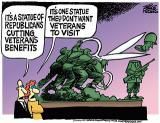The veteran participating in living history will find a sense of belonging that only a veteran can truly understand
August 08, 2014 - With the recent attention focused on the sesquicentennial of the American Civil War, the centennial of the start of World War I, and the 70th anniversary of D-Day, living historians, or reenactors, are in the public eye. The allure of joining their ranks goes beyond firing weapons to deeper motivations for veterans.
The camaraderie found in military units is hard to find elsewhere. The bonds formed by people united in a common purpose and then subjected to hardship are well-forged. While different from those formed in combat, the relationships established through reenacting can be quite strong. Although participation is voluntary, the camaraderie is genuine.
Portraying a soldier on campaign, wearing and carrying only what they did in that particular era, preparing and sharing rations, and making shelter in the heat of summer or the chill of spring can only be accomplished by the steadfast dedication and cooperation of all members of the unit. Just like modern-day soldiers, reenactors need to look out for one another.
The procedures followed at a living history encampment can feel restricting to the average civilian, but are as comfortable to the veteran as a broken-in pair of combat boots. This familiarity allows for a more natural participation and portrayal of the soldiers of the past. Marching in step with a drum or cadence is second nature, as is the wearing of a uniform. Anyone who has stood for a pass and review or change of command will easily recognize the daily parade that is held to post orders and provide accountability. Reenactments provide a structured environment that feels normal and comforting. read more>>>























No comments:
Post a Comment